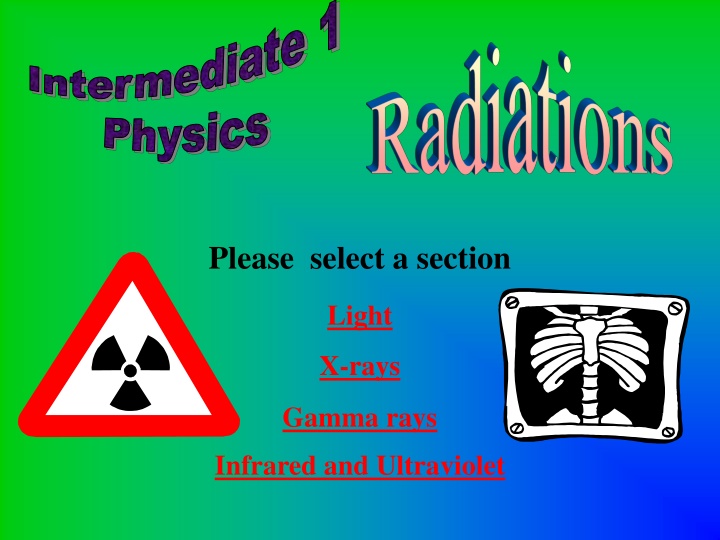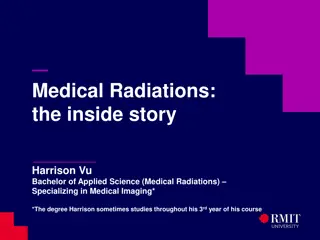
Light and Optical Instruments
Explore the properties of light, including reflection, refraction, and the use of optical instruments like lasers, mirrors, and lenses. Discover how optical fibers and endoscopes are utilized in medical settings to gather visual information inside the human body. Learn about the different types of lenses and their applications in changing the direction of light.
Download Presentation

Please find below an Image/Link to download the presentation.
The content on the website is provided AS IS for your information and personal use only. It may not be sold, licensed, or shared on other websites without obtaining consent from the author. If you encounter any issues during the download, it is possible that the publisher has removed the file from their server.
You are allowed to download the files provided on this website for personal or commercial use, subject to the condition that they are used lawfully. All files are the property of their respective owners.
The content on the website is provided AS IS for your information and personal use only. It may not be sold, licensed, or shared on other websites without obtaining consent from the author.
E N D
Presentation Transcript
Intermediate 1 Please select a section Light X-rays Gamma rays Infrared and Ultraviolet
Intermediate 1 Please select a section Light X-rays Gamma rays Infrared and Ultraviolet
Light Light A laser beam is a concentrated source of light of only one colour. The laser beam when used in surgery will seal blood vessels as it cuts, reducing damage to the patient. The laser can be used in eye surgery to repair the retina. It can also be used to remove birth marks and tumours from the body.
All light can be reflected. All visible objects give out, or reflect, light to the eye. If light is shone on to a plane (straight) mirror the angle at which it is reflected is the same as the angle of entry. the angle of incidence = the angle of reflection.
An optical fibre is a long, thin solid piece of glass or plastic which can reflect light along its length by what is known as Total Internal Reflection. Optical Fibre Optical fibres can be used in hospitals as Endoscopes .
Endoscopes (Fibroscopes) are two bundles of fibre optic joined together. The endoscope is used to collect visual information from inside a patient. The first bundle of fibre carries light into the patient. The light then reflects off the inside of the patient. The second bundle of fibre then carries the light back to the doctors eye where diagnosis can be made.
Lenses can be used to change the direction in which light travels. There are two types of lens. The converging lens and the diverging lens Thick in the middle Thin in the middle Thin at the ends Thick at the ends
The converging lens (sometimes known as a convex lens) is used to bring rays of light together. A fatter lens will be stronger. A fat lens will bring the rays of light together closer to the lens than a thin lens.
The diverging lens (sometimes known as a concave lens) is used to move rays of light further apart. A fatter lens is again stronger and will cause the rays of light to spread out more.
The human eye is a very complex part of the body. It is made up of various parts: Pupil Iris The pupil of the eye is a hole which allows light to enter the eye. The iris of the eye (the coloured part) can change size. The iris will contract in darkness - this makes the pupil larger and therefore more light enters the eye. In bright light conditions the iris makes the pupil smaller. This reduces the amount of light entering the eye, thus preventing damage to the retina.
Side view of the eye: cornea optic nerve lens iris pupil retina
When light enters the eye from a distance we consider the light rays to be parallel. The lens of a healthy eye is thin in order to focus these rays on the retina. When light enters the eye from nearby the rays of light are diverging. The lens of a healthy eye is fat in order to focus these rays on the retina.
If a person is short sighted, their eyes can focus rays of light from nearby objects but not from distant objects. This means they can see nearby objects clearly. The reason they cannot see distant objects is that the lens of their eye cannot be made thin enough. Short sight This problem can be resolved by placing a concave lens in front of the eye. This results in the eye focusing the rays of light SHORT of the retina.
If a person is long sighted, their eyes can focus rays of light from distant objects but not from nearby objects. This means they can see distant objects clearly. The reason they cannot see distant objects is that the lens of their eye cannot be made fat enough. Long sight This problem can be resolved by placing a convex lens in front of the eye. This results in the eye focusing the rays of light behind the retina.
Return to start of Radiations Advance to next section
Return to start of Radiations Advance to next section
X X- -rays rays X-rays are invisible to the naked eye. If an X-ray hits a piece of photographic film it will appear as a black area on the developed film. X-rays can be used to find broken or fractured bones inside a person s body.
An X-ray picture is produced by placing the patients body between an X-ray source and a piece of photographic film. The bones absorb the X-rays and prevent areas of the film being hit. These areas appear as white patches on the developed film. Parts of the bone which are broken allow the X-rays to pass through the bone and appear as black parts on the developed film. X-rays are dangerous since they can damage living cells.
X-ray machines can be used in industry: They are commonly used in airports to inspect luggage for security reasons. X- rays are also used to inspect weld joints.
Return to start of Radiations Advance to next section
Return to start of Radiations Advance to next section
Gamma Rays Gamma Rays Gamma radiation is invisible to the naked eye. Gamma radiation can kill living cells or change the nature of living cells. Gamma radiation can pass through most materials.
Radioactive material is easy to detect because of the radiation it gives out. Hospitals can use a radioactive tracer to study the working of various parts of the body. To do this they inject the patient with a radioactive source. This source is usually a gamma source as it can be detected outside the body. The doctors would then use a gamma camera to follow the tracer around the patients body. The strength of the gamma radiation reduces with time.
When working with gamma radiation be sure to follow these simple safety procedures: 1. Never point a radioactive source towards anyone (including yourself). 2. Always use forceps or tongs to handle sources. 3. Store sources in lead lined boxes. 4. Always label radioactive sources Note that gammaradiation is present in our surroundings.
Return to start of Radiations Advance to next section
Return to start of Radiations Advance to next section
Infrared and Ultraviolet Infrared and Ultraviolet Infrared radiation is invisible to the naked eye. Infrared radiation is called heat radiation. Infrared radiation is used in hospitals to treat strained muscles. Infrared is also used in thermograms. These are coloured pictures in which hot areas show as a red colour. This can be used to find tumours as they are warmer than surrounding tissue. Police use thermal imaging cameras which detect body heat in the same way. This enables them to find hiding criminals in a chase.
The sun gives out ultraviolet radiation. We can not see ultraviolet radiation with the naked eye. This is the radiation that gives us a suntan. If you spend too long in natural sunlight your skin will burn. Excessive exposure to ultraviolet radiation may cause skin cancer.
Ultraviolet radiation is used in medicine to treat skin diseases such as acne and psoriasis. Ultraviolet is also used to sterilise medical instruments as it kills bacteria. Some chemicals will fluoresce (glow) when they absorb ultraviolet radiation. This is used in security markings in bank notes. The markings can not be seen without an ultraviolet lamp, but when you shine the lamp on to the notes, the markings become visible.











